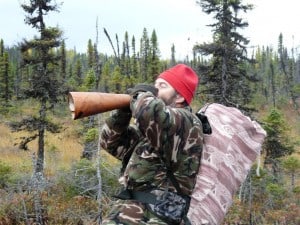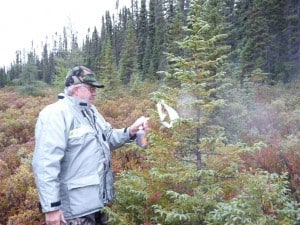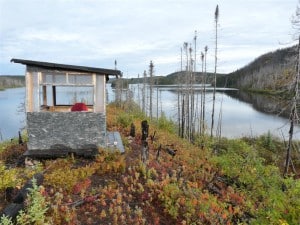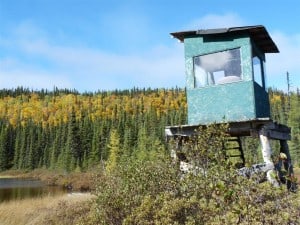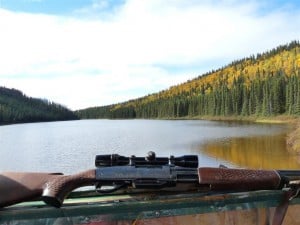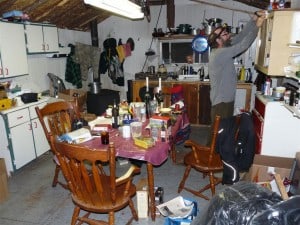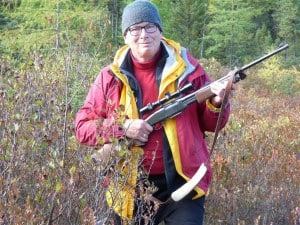Heavy bodied and long-legged, Moose (Alces alces) are the largest inhabitants of the boreal forest. A mature bull can easily weigh 1000 lbs and measure almost seven feet tall at the top of the back hump. In late September, Moose are in rut – a period of high sexual energy as aggressive bulls compete for cows. It is also the time of year when Moose hunters across Canada head to the woods. This fall, thanks to my friend, Raynald Pilon, and his hunting partner, Claude Moisan, I got to go along. Our destination was Rene-Levasseur Island on the huge Manicouagan Reservoir of northeastern Quebec.
Moose hunting involves far more than I ever imagined. First and foremost, Raynald and Claude impressed upon me the importance of being quiet. Moose have extremely acute hearing, along with the ability to pin point the exact location of any sound. It is therefore necessary to keep conversation to a minimum, whisper when you really need to say something and wear clothing such as wool and synthetic fleece that doesn’t make unnatural sounds. Gore-Tex, polyesters and even jeans can be quite noisy and are to be avoided. If a Moose hears something that is not part of the natural soundscape, it won’t be sticking around for long. However, noises such as branches breaking do not arouse suspicion. They are sounds that Moose are used to, as are the various vocalizations that these majestic mammals make.
For hunters, being able to accurately imitate the Moose’s different calls is an essential skill. Claude and Raynald both use a traditional birch bark cone for this purpose. The cone serves to greatly amplify their voices. They mimic both the short, throaty grunts – a sort of “ouuahhhh” – of the bull and the longer-lasting plaintive moans of the cow. The wail of a cow in heat can be heard for several kilometres in calm weather. Bulls within hearing distance will move towards her, making grunting sounds as they approach. However, the bull knows he’s not the only suitor with sex on the brain and fully expects to see and hear other males. By imitating the grunts, the hunter can therefore entice a bull to present itself, since the animal assumes there is probably a female nearby as well. Claude was particularly addicted to mimicking Moose grunts and couldn’t stop making the sound, even back at camp during supper!
To further advertise his presence to opponents, the bull will aggressively thrash small trees and shrubs with his antlers. As you might expect, hunters do this, too. Claude actually had a section of antler from a previous hunt that he used for this purpose. If there is a Moose in the vicinity and it hears these thrashing sounds, it is likely to come in to investigate. If two bulls should actually meet while courting a female, they will sometimes spar with one another. More often, however, the bull with the smaller antlers simply retreats without a fight.
Moose also have an incredibly keen sense of smell. During the rut, a bull will often dig a muddy pit in which he urinates. He will then lie in the pit to “perfume” himself. The scent will not only attract cows but serves to advertise his presence to other bulls. The urine of a cow in heat is also a powerful attractant. And yes, hunters take advantage of this, too. I watched in bewilderment as Raynald and Claude sprayed synthetic Moose urine on rags, which they had attached to small trees around their hunting blinds. This is powerful stuff. I ended up getting a bit on a glove and I can still smell it.
The Daily Routine
We got up each morning at about 6 a.m., had a copious breakfast, dressed warmly – the temperatures was 3-8 C most days and there was often rain – and were out into the field by 7:30 most days. We didn’t return to camp until dark, since Moose are often quite active late in the day. Claude hunted from one of five blinds or stands – small, elevated, wooden shelters with windows on three sides – that he and Raynald have constructed over the years. Hunting from a blind mostly involves sitting quietly and hoping that an animal will present itself – possibly lured in by the calls, thrashing and scents described above. Raynald, however, prefers to actually stalk the animals. I had the pleasure of accompanying him one day to see how this is done.
Walking slowly through the woods and often along well-trodden trails used by the Moose, we stopped every minute or so to look and especially to listen. On a calm day, it’s possible to hear the grunts, moans or breaking branches made by a Moose at considerable distances. We also kept an eye out for signs of recent Moose activity such as fresh tracks, droppings, rubbed tree trunks or browsed willow twigs. On several occasions, Raynald also used his voice and cone to imitate the wail of a cow Moose. Over the course of the day, we walked – and, in one section, paddled – at least five kilometres through bogs, alder swamps, over Beaver dams and across a huge area that had succumbed to a forest fire in 2005. Negotiating our way through the obstacle course of fallen, charred trees was quite the challenge. Fortunately, we had a hand-held GPS to help with direction. Although we didn’t find any Moose – or even any recent signs – there was always something of interest to photograph or identify. We inspected several piles of wolf scat, flushed Spruce Grouse, ate big handfuls of delicious blueberries, and were always surrounded by stunningly beautiful scenery. As Raynald explained to me, the pleasure of “la chasse fine” – as it is called in French – comes from putting all of your knowledge of Moose behaviour to the test, as well as your physical stamina and powers of concentration and patience. There is also the aesthetic pleasure of being so closely in touch with the land. All of this makes the satisfaction of an eventual kill all the greater.
Whereas Raynald stalk hunted most days, Claude and I would usually each take a canoe and head off to separate blinds in different arms of the lake. In addition to a rifle, I took along binoculars, a camera, various field guides and a journal. Being able to spend an entire day in one location simply watching, listening and experiencing total solitude was a rare treat. Here are a few extracts from my journal.
07:50 – Arrive at watch in NE fork of Lac Fourchette. Sunny and clear. Beautiful juxtaposition of the dark green of the Black Spruce, smoky gold of the Tamarack and lemon yellow of the White Birch.
08:01 – Pair of loons arrive on bay.
08:10 – Red Squirrel scolds loudly. Probably upset by my presence.
09:15 – Notice several Beaver lodges along the shore. One has winter food pile with leaves still on branches.
10:00 – Surprisingly loud, squeaky whistles of a Gray Jay. Lands on salt lick.
11: 18 – Common Raven flies over, calling loudly.
12:00 – Sun is finally warm. Removed a couple of layers of clothes.
14:00 – Go for a walk. See Brook Trout in stream. Try to identify some of the mosses and lichens.
15:03 – Utter quiet except for wind, waves lapping up on shore and rattling of windows in the blind.
15:57 – Sun is now in the western sky. Birches shining golden in its rays.
18:00 – Head back to camp. Silence of electric motor allows me to get within 10 feet of Beaver with aspen twigs in its mouth.
Each day concluded with a magnificent meal – usually Moose meat, courtesy of the animal they killed last year. We also enjoyed one of Raynald’s Landlocked Salmon from the Manicouagan and Claude’s smoked Brook Trout, taken from Lac Fourchette this past July. Then, over a glass of port, the two long-time hunting partners regaled me with stories of past hunts such as one very memorable bull, “Richard the Lionhearted.”
More about him next week.
